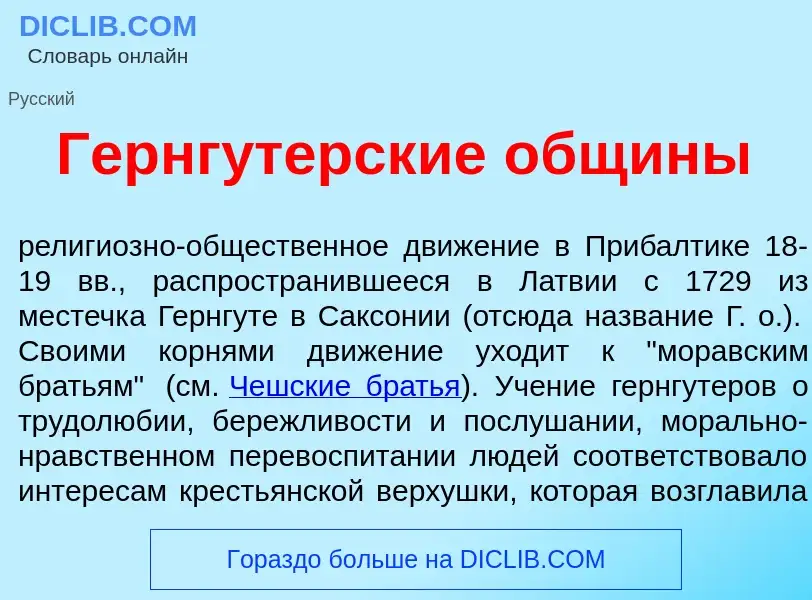أدخل كلمة أو عبارة بأي لغة 👆
اللغة:
ترجمة وتحليل الكلمات عن طريق الذكاء الاصطناعي ChatGPT
في هذه الصفحة يمكنك الحصول على تحليل مفصل لكلمة أو عبارة باستخدام أفضل تقنيات الذكاء الاصطناعي المتوفرة اليوم:
- كيف يتم استخدام الكلمة في اللغة
- تردد الكلمة
- ما إذا كانت الكلمة تستخدم في كثير من الأحيان في اللغة المنطوقة أو المكتوبة
- خيارات الترجمة إلى الروسية أو الإسبانية، على التوالي
- أمثلة على استخدام الكلمة (عدة عبارات مع الترجمة)
- أصل الكلمة
%ما هو (من)٪ 1 - تعريف
ОПИСАНИЕ СТРУКТУРЫ
Общины Андорры
Гернгутерские общины
религиозно-общественное движение в Прибалтике 18-19 вв., распространившееся в Латвии с 1729 из местечка Гернгуте в Саксонии (отсюда название Г. о.). Своими корнями движение уходит к "моравским братьям" (см. Чешские братья). Учение гернгутеров о трудолюбии, бережливости и послушании, морально-нравственном перевоспитании людей соответствовало интересам крестьянской верхушки, которая возглавила Г. о. Своим кажущимся демократизмом - все члены общины назывались братьями и выбирали из своей среды старост - Г. о. привлекали массы латышского и эстонского крестьянства, которое искало в гернгутерстве освобождения от немецких помещиков и пасторов. Деятельность Г. о. достигла наибольшего размаха в 1-й половине 19 в. В 1828 в Прибалтике числилось свыше 40 тыс. гернгутеров. Во 2-й половине 19 в. численность Г. о. быстро сократилась. Отдельные очаги движения существовали ещё в начале 20 в.
Лит.: Остзейский вопрос в XVIII в. [Сб.], Рига, 1946; Zutis J., Vidzemes un Kurzemes zemnieku briviaišana, Riga, 1956; Eesti kirjanduse ajaluqu, kr. 1, Tallin, 1965.
М. К. Степерманис.
Община (Англия)
Общины Англии
Община (, букв. «административный приход») — составляет самый низший уровень административного деления АнглииJones, B.
Коммуны Норвегии
АДМИНИСТРАТИВНАЯ ЕДИНИЦА 2 УРОВНЯ
Муниципалитет в Норвегии; Коммуна Норвегии; Коммуна (Норвегия); Общины Норвегии
Коммуны () являются вторым административным уровнем деления Норвегии после губерний (фюльке). К концу 2018 года в стране насчитывалось 422 коммун.
ويكيبيديا
Административное деление Андорры

Андорра в административном отношении разделена на 7 общин (кат. parròquies, ед. ч. кат. parròquia — «приход, паррокия»). Последняя, седьмая община — Эскальдес-Энгордань была образована в 1978 году.
Некоторые общины имеют дальнейшее территориальное деление. Некоторые делятся на четверти («кварты», кат. quarts):
- Ордино — 5 quarts: Sornàs, Ansalonga, la Cortinada, Llorts и собственно Ордино.
- Ла-Масана — 7 quarts: Pal, Arinsal, Erts, Sispony, Anyós, l’Aldosa и столица Массана
- Сан-Жулиа-де-Лория — 5 quarts: Quart de Bixessarri, Quart d’Aixirivall, Quart d’Auvinyà, Quart de Fontaneda и Quart de Nagol.
а Канильо разделён на кат. veïnats («соседства»), соответствующие деревням, которые имеются в других общинах.


